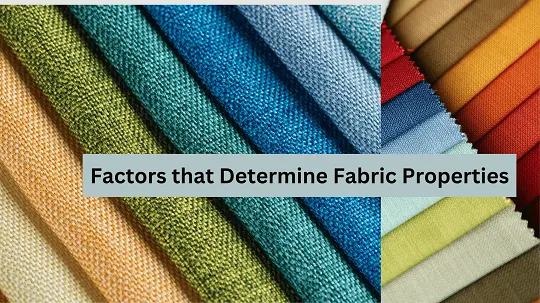Different Factors that Determine Fabric Properties
A manufactured assembly of fibers and yarns that has a substantial surface area in relation to its thickness and sufficient cohesion to give the assembly useful mechanical strength is called fabric. The fabric has many properties. For different purposes, we need to determine fabric properties. In this article, I will give factors that determine fabric properties.
Many factors play a role in the setting of a fabric property from fiber to fabric finishing process. Those are Fiber properties, Yarn properties, Fabric construction, Weave structure, and fabric finishing process.

Different Factors that Determine Fabric Properties:
A. Fiber properties:
- Chemical content
- Molecular weight
- Molecular arrangement
B. Yarn properties: (The thickness, twist, and ply of the yarn can all affect the fabric’s drape, weight, and texture. For example, a tightly twisted yarn will create a smoother and stronger fabric, while a loosely twisted yarn will create a softer and more drapey fabric)
- Fiber Types: Common fibers are natural fibers (cotton, linen, wool, silk) and synthetic fibers (polyester, nylon, acrylic).
- Fiber properties
- Fiber arrangement
- TPI- Twist Per inch
- Yarn Types according to the manufacturing process: Examples are Carded Yarn, Combed Yarn, and Rotor Yarn.
C. Fabric construction: Fabric construction refers to the way that the fibers are woven or knitted together, EPI, PPI, and Yarns count in the fabric.
- EPI- Ends per inch
- PPI- Picks per inch
- Warp Yarn count
- Weft Yarn count
D. Weave structure: ( Fabric weaving types)
- Plain
- Twill
- Satin
- Derivatives
E. Basic knit structure:
- Plain
- Rib
- Purl
- Interlock
- Derivatives
F. Fabric engineering:
- Yarn specification
- Fabric specification
- Yarn crimp
- Weave structure
G. Fabric finishing and Dyeing Process:
- Dyeing Process
- Mechanical or physical finishing
- Electrical finishing
- Physio chemical finishing
Textile manufacturers can adjust these variables to produce fabrics with a variety of characteristics. For example, Sportswear-grade fabric, for instance, could be composed of robust, breathable, and moisture-wicking synthetic fibers. Conversely, a cloth meant for an elegant dress could be composed of silky, opulent, and naturally wrinkle-resistant natural fibers.
- You may love to read: What is Fabric Specification Sheet?
